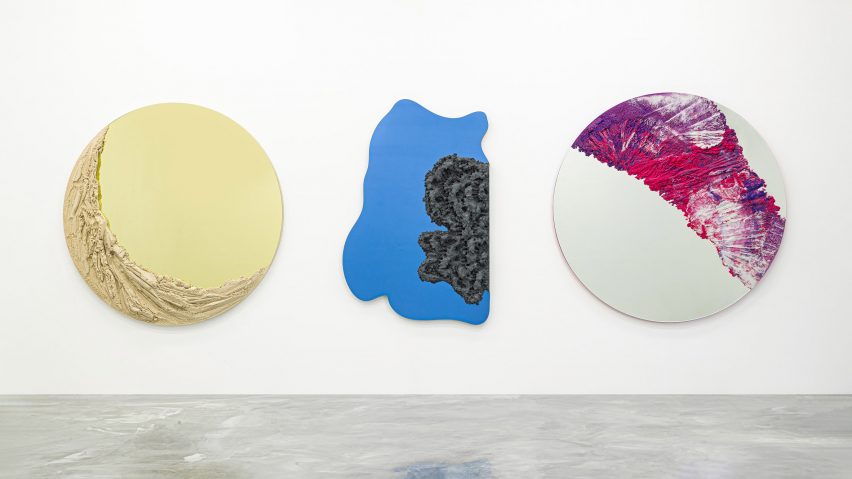From a trio of mirrors depicting Dubai's arid landscape to a set of sand-cast chairs by female artisans in Sharjah, Dezeen's Natashah Hitti has picked seven designs from Downtown Editions 2019 that celebrate regional traits.
Held during Dubai Design Week, Downtown Editions took place for the second time this year as part of the city's Downtown Design fair, which has been held annually since 2013.
The event, which ran from 12 to 15 November, is dedicated to showcasing bespoke and limited-edition designs by both established and emerging designers and brands, with a focus on the Middle East.
As a former journalist and attendee of previous fairs, director Rue Kothari wanted to take a different, more curatorial approach to the event to create a trade fair that is "by the industry, for the industry".
"Downtown Design represents a crucial link in the region's design ecosystem," said Kothari. "We are committed to creating an experience that nurtures both exhibitors and visitors."
"This will become an exciting alternative to traditional design fairs; showing what's innovative and relevant, while representing the spirit and dynamism of our smart, emerging economy," she added.
Read on for our pick of seven bespoke designs that spotlight elements of the scene:
Capital Collection by Fernando Mastrangelo
This trio of mirrors by New York-based designer Fernando Mastrangelo references the varying aspects of Dubai's landscape as a "tribute" to the region.
Debuted at Downtown Editions, each mirror in the Capital Collection is handmade using hand-dyed sand mixed with resin.
The golden-hued Sahara mirror references the two main elements of Dubai, sun and sand, while the irregular-shaped Marina mirror represents Dubai's famous waterways, with grey sand designed to emulate the steel structures of the region's man-made cityscape.
The third Aurora mirror features a swathe of pink and purple-coloured sand, paying homage to the colourful sunsets in the city.
Hajar chair by the Irthi Contemporary Crafts Council
Based in Sharjah in the UAE, the Irthi Contemporary Crafts Council is dedicated to "empowering women" with craft through its creative, cultural and commercial initiatives.
One of these initiatives, the Safeefah x Sand Casting Design Lab, saw a group of female artisans collaborate with Architecture + Other Things to produce a collection of sand-cast furniture, including a table and a set of chairs.
Each piece in the Hajar collection is handmade using a combination of water, sand, concrete, clay and soil, and upholstered with beige camel leather.
Ideas Taking Shape collection by Design Kraft
Dubai-based studio Design Kraft presented a collection of playful furniture at this year's Downtown Editions fair, comprising a series of vibrant tables and lighting.
Titled Ideas Taking Shape, the furniture was inspired by designer Sidarth Menon's newborn daughter, who was making "surrealist-like" forms with Play-Doh when he realised how simple shapes can be reimagined in a playful and creative way.
As Menon explained, the collection is about expressing yourself. He combined refined materials like marble and onyx with bold colours and shapes to create pieces that are both playful and minimal, as an alternative to the maximalist patterns that often inform traditional Middle Eastern design.
Safeefah chair by the Irthi Contemporary Crafts Council
Emirati artisan Ghaya Bin Mesmar collaborated with Laura Blasco, Juanmi Juárez and Alex Estévez from Barcelona-based Mermelada Estudio to make this chair from a combination of old and new Safeefah palm-weaving techniques.
The design was inspired by images of traditional Areesh houses found in the UAE desert, which are made from palm fronds. One of the images showed an Areesh blown down by the wind, making it look like a "majestic cone".
The designers saw the potential to turn this cone-like form into a seat, informed by themes of privacy and protection.
Katta by Yara Habib for Tashkeel
Emirati art facility Tashkeel presented this screen-divider at Downtown Editions, which was created by Dubai-based designer Yara Habib as a nod to the traditional Bedouin communities.
Based on the interior dividers typically used in the Bedouin tents, Habib's Katta design comprises 400 elements made from a variety of materials, with individually hand-woven wooden panels inspired by authentic UAE patterns.
Each individual panel can rotate to provide "personalised privacy". Made from wood, aluminium, corian and faux suede, the complex process of weaving the threads into each panel is a way for the designer to connect with the Bedouin history.
Preservation bench by Houtlander
South African designers Stephen Wilson and Phillip Hollander from Houtlander studio presented their Preservation Bench at this year's Downtown Editions fair.
Three benches curve upwards to create a singular "gravity-defying" twisted form, designed to emulate the sapling growing from the forest floor and up towards the canopy.
Created in partnership with the American Hardwood Export Council, the bench is made from thermally modified American white oak and doesn't use screws or mechanical fixings in its production in a bid to be as sustainable as possible.
The studio calculated that all the white oak used to make the bench would be replaced through natural regeneration in the US hardwood forest in less than one second.
Ten Tables by Binchy and Binchy
Contemporary design practice Binchy and Binchy aimed to preserve the region's heritage when creating this collection of tables, inspired by different architectural structures across the UAE.
The studio combined traditional materials and Middle Eastern patterns with modern technologies that are frequently used in large-scale construction, such as laser etching, 3D printing, water-jet cutting and CNC milling.
Each of the pieces' bases are made from thousands of sheets of compressed paper that are taken from old books and photographs about the region, to create "a historic archive transformed to stone".

